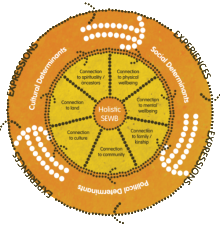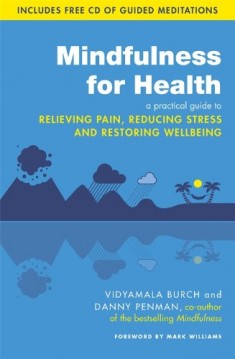If we are to help Indigenous people improve their health and well-being, then we must understand the nature of the problems. Sadly, parts of government do not have that understanding, as illustrated by Professor Judy Atkinson. [View from 9’20” until 17’39”]
Understanding Indigenous Wellbeing
 “Indigenous people have a holistic view of health and wellbeing that incorporates the physical, spiritual, mental, emotional, scial and environmental. It does not just focus on the individual, but also on the health and wellbeing of the community.”
“Indigenous people have a holistic view of health and wellbeing that incorporates the physical, spiritual, mental, emotional, scial and environmental. It does not just focus on the individual, but also on the health and wellbeing of the community.”
Indigenous Heath and Wellbeing
To appreciate the many ways that society can facilitate the healing of Indigenous people, we must understand the Indigenous view of health and wellbeing. It is different to that of western culture.
Indigenous people have a holistic view of health and wellbeing that incorporates the physical, spiritual, mental, emotional, social and environmental. It does not just focus on the individual, but also on the health and wellbeing of the community.
This view, which has been in existence for tens of thousands of years, is far richer than the western concept of mental health, which comes from an illness or clinical perspective.
’Self-Determination in Mental Health Recovery: Taking Back Our Lives (Part 1)’ by Mary Ellen Copeland
 This morning I was thinking about factors that facilitate healing amongst Indigenous people in preparation for some content I’m writing for Sharing Culture. I first thought ‘self-determination’. We know that self-determination is key for recovery, yet the white-dominated society here (and in other colonised nations) forces its way of doing things on indigenous people, even when it does not work.
This morning I was thinking about factors that facilitate healing amongst Indigenous people in preparation for some content I’m writing for Sharing Culture. I first thought ‘self-determination’. We know that self-determination is key for recovery, yet the white-dominated society here (and in other colonised nations) forces its way of doing things on indigenous people, even when it does not work.
Anyway, I googled self-determination, and came up with this excellent article by Mary Ellen Copeland. I thought I would upload Mary Ellen’s article in several parts.
‘The most important aspect of mental health recovery for me personally is self-determination. My connection with people in the system and in recovery has convinced me that the same is true for others.
In this paper I will discuss both my personal perspectives and the perspectives of others on this important topic based on many years of experience as a person, a user of mental health services, a researcher and a teacher.
Indigenous social and emotional wellbeing
 Indigenous people have a holistic view of health that incorporates the physical, spiritual, mental, emotional, social and environmental.
Indigenous people have a holistic view of health that incorporates the physical, spiritual, mental, emotional, social and environmental.
It includes healing oneself and relationships with others, such as family and community members. It recognises the importance of connecting to land, culture, spirituality and history, as well as the importance of bonds of reciprocal affection, responsibility and caring.
The Indigenous view of health people also recognises the importance of healing the community, rather than just focusing on the individual.
Indigenous people focus on social and emotional wellbeing, rather than on mental health. They view social and emotional wellbeing problems arising from a broad range of circumstances – unresolved grief and loss, trauma and abuse, domestic violence, removal from family, substance misuse, family breakdown, cultural dislocation, loss of land, racism and discrimination, and social disadvantage.
‘Dis-ease’ by Phil Hanlon
I continue the series of videos made by Phil Hanlon, Professor of Public Health at Glasgow University. Check out all the video and writings on Phil’s Afternow website. I love this website – what Phil has to say is very important.
‘In this video Phil Hanlon suggests that the public health problems we now face (such as obesity, enduring health inequalities, the rise in mental distress, and increasingly problematic use of drugs and alcohol) have a common source: they are the result of the increasingly adverse effects of the mindset and approach which characterises modernity.
They can helpfully be thought of not as ‘diseases’ but as ‘dis-eases’, associated with modernity.
He suggests that the biggest problem we face may be modernity itself, which means that the health and wellbeing issues which confront us can no longer be addressed by conventional forms of thinking, tools or approaches.
We now face what might be called an ‘ingenuity gap’. This is the gap between the problems we face and the adequacy of the tools available to create solutions.’
‘The crisis of modernity’ by Phil Hanlon
Recently, I introduced you to Professor Philip Hanlon. Mark Gilman had told me about Phil and his work and I am excited by what he and his colleagues are doing. Over the coming weeks, I’m going to show a series of film clips which describe Phil’s Afternow project.
On the relevant webpage, Phil says:
‘Modernity has brought many benefits (including technological improvements, material comfort, longer life expectancy and improved health), but the downside includes the emergence of new problems which stem from the way we live our lives and structure our society.
Recommended book: Mindfulness for Health
 Pain, suffering and stress can be intolerable – but it doesn’t have to be this way.
Pain, suffering and stress can be intolerable – but it doesn’t have to be this way.
Mindfulness for Health reveals a series of simple practices that you can incorporate into your daily life to relieve chronic pain and the suffering and stress of illness. Clinical trials show that mindfulness meditation can be as effective as prescription painkillers and also enhances the body’s natural healing systems. Mindfulness can also reduce the anxiety, depression, irritability, exhaustion and insomnia that can arise from chronic pain and illness.
Mindfulness for Health is based on a unique meditation programme developed by Vidyamala Burch to help her cope with the severe pain of spinal injury. Taught at Breathworks in the UK – and its affiliates around the world – this programme has helped tens of thousands of people cope with pain, illness and stress.
The eight-week programme at the heart of this book takes just 10-20 minutes per day. You’ll be surprised by how quickly your suffering melts away, leaving behind a deep-seated love of life.



